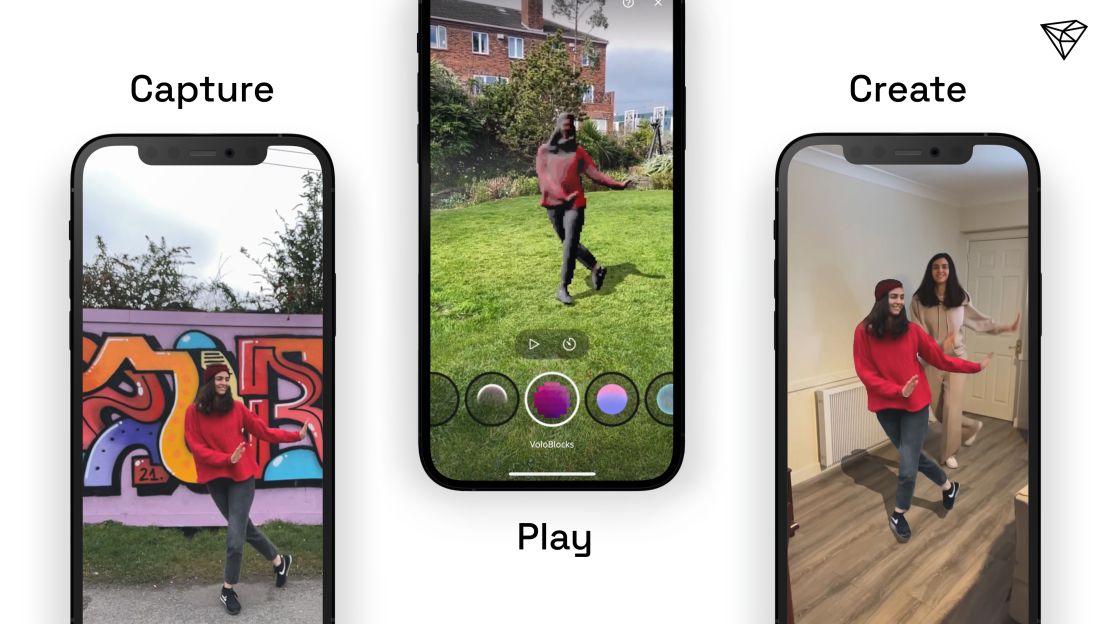When you see a 3D image of a real person in a video game or as a visual effect in a movie, that virtual human has usually been constructed through an intricate process known as “volumetric capture.”
Dozens of cameras surround the subject and record a 360-degree video, capturing its dimensions and volume. The different viewpoints are then merged to create a digitized 3D image. Typically, the process is carried out by technicians in a professional studio — both time-consuming and expensive.
But this could be about to change, as Irish startup Volograms has made the process available to anyone with an iPhone via its free app Volu. Launched on the App Store in September and soon to be available on Android, it’s the first content creation app capable of turning standard mobile video into augmented reality, Volograms says.
While the phone camera only captures video from one angle, the app uses artificial intelligence to estimate the 3D shape and texture of a person in areas that the camera does not see. It uses algorithms that have been trained on thousands of human models captured in Vologram’s professional studios. Then it converts the moving image to a hologram, or what the company refers to as a “vologram.”
Users can then play with the vologram in creative ways, shrinking or enlarging the figure and superimposing it on any backdrop, adding filters that change the transparency or color of the image, and mixing realities by adding a virtual doppelganger to a standard video.
The aim, says Rafael Pagés, the company’s CEO and co-founder, is to make augmented reality (AR) and virtual reality (VR) content creation available to the everyday consumer.
“We wanted to create something that would enable anyone, not just the professionals, to create content, play with it, share it,” he tells CNN Business.
Rising interest
Volu is also answering a growing demand for AR and VR content. A report from market research firm eMarketer estimates that this year in the United States alone, almost 60 million people will use VR and more than 90 million will use AR at least once per month — a rise of 36% and 28% respectively, compared to 2019.
The technology is mostly used for gaming, entertainment and social media, but as consumers and businesses test out immersive experiences, a wider variety of applications could emerge. The Covid-19 pandemic has also driven interest, with people experimenting with AR and VR technology to replicate in-person meetings in a virtual setting. Facebook (FB) has launched a VR app that lets users (represented by customizable avatars) sit in a virtual conference room with coworkers, and this week announced plans to hire 10,000 people in Europe to build the “metaverse.”

Other companies have also stepped up to meet the demand. UK-based Dimension, which has partnered with Microsoft (MSFT), creates 3D videos in its high-tech studio, ranging from fashion shows to sports events. 4D Views, a French company, designs and sells its volumetric video capture technology to studios around the world.
But Volograms, which says it has raised €2.3 million ($2.7 million) in funding since it was founded in 2018, is one of the few making volumetric capture available to everyday consumers. The Volu app is free, although the company says it plans to incorporate paid-for “pro features.” Currently, Volograms’ main source of income still comes from its professional studio service.
Cathy Hackl, a tech futurist specializing in AR and VR, believes that there’s strong demand for both “high quality Hollywood content” produced by professionals and amateur content created on a smartphone. But the latter will be crucial in driving mass adoption of the technology, she says.
“Giving the tools to people now, so that they can access [the technology] on their phones and create this content is very powerful,” she tells CNN Business.
By breaking down the barriers to entry, Pagés hopes Volu will empower a “new generation of creators” and transform communication as we know it.
“This is just the beginning,” he says. “Right now it lives in an app and you can create fun, engaging content there to share with your friends and family. But we think this technology could be easily integrated into the headset or into [smart] glasses, so that it can become the next generation camera.”







